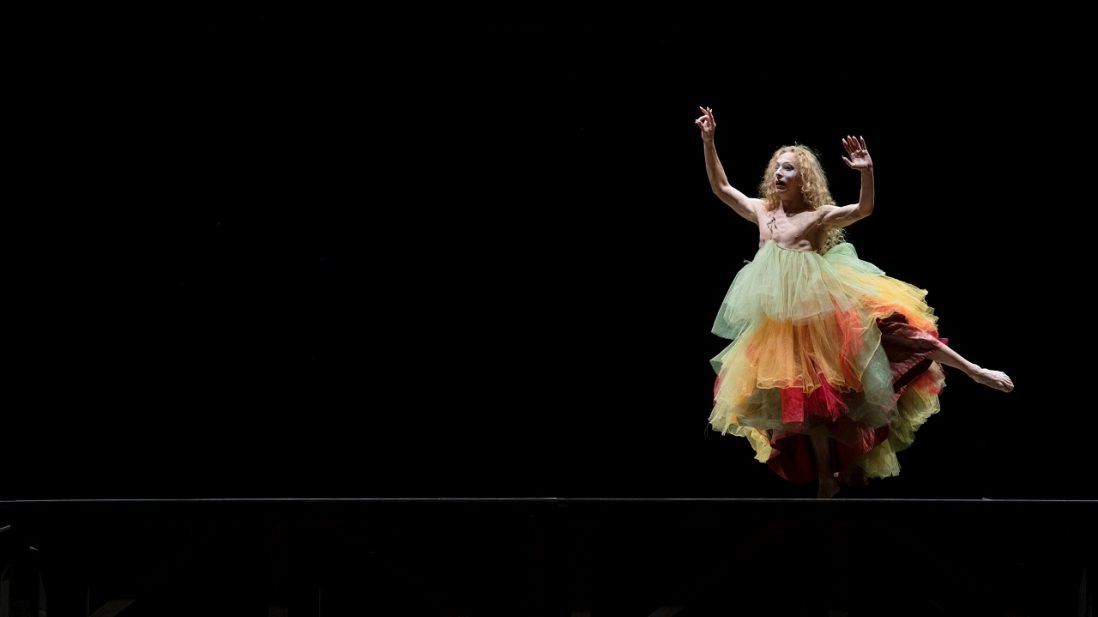Many of us know the theme of Maurice Ravel’s Bolero, perhaps even hum it, free from context. However, prior to becoming a work in its own right, the music had been composed for a ballet. It was Ida Rubinstein, a Russian dancer and Ballets Russe’s muse, who asked for the musical score from Ravel, and Bronislava Nijinska –the famous dancer Vaslav Nijinski’s sister – who choreographed the first stage version of it. In this 18-minute piece, Dominique Brun retraces the thread of choreographic writing, and revives the memory of Nijinska, the first and only female choreographer of the Ballets Russes. Inviting François Chaignaud to interpret the dance and to share its writing, Brun confronts Un Bolero with others dances, including Flamenco, Skirt Dance and Tatsumo Hijikata’s Butoh. Wearing a long dress, the dancer alternates twirling, staccato of the foot, and slow motion of the arms and torso, his body resisting the martial rhythm and thus thwarting the music’s authority. From the start, Bolero was the collaborative effort of Nijinska, composer Maurice Ravel and painter Alexandre Benois, also a librettist and scenographer. Benois and Nijinska conceived of a libretto different to the one imagined by Ravel, who had situated the action in a factory, in which the male dancers would progressively enter the dance. Benois persuaded Ravel to follow a different scenario: a Spanish tavern, a female dancer, and men caught in a trance. The secret sensuality of the music is articulated through the whirling of the skirt, like those of Flamenco dancers, of the French cancan, or even the floral silks of Loïe Fuller. In Helsinki, Un Bolero is accompanied by two pianists on one piano, in collaboration with the Sibelius Academy.
Dominique Brun
Choreographer, dancer, teacher, and dance recorder in Labanotation, Dominique Brun has danced since the 1980s. She is passionate about the rediscovery of our choreographic heritage, not as museum objects but rather to spark a relationship between the available archives and today’s performers. She favors the use of Labanotation but also the use of numerous sources and archives –such as photographs and films from the period, literary texts, sketches and notes – that allow for understanding and giving new life to former and often forgotten pieces. She casts a decidedly contemporary gaze on these erstwhile pieces and seeks to give them visibility through the work of interpretation, seeking not to reconstruct but rather to reinvent. Alongside her creations, Dominique Brun finds passion in teaching contemporary dance and regularly works in high schools, art schools, and in advanced dance trainings.
François Chaignaud
Born in Rennes, François Chaignaud has studied dance since the age of six. He received his diploma in 2003 from the Conservatoire National Supérieur de Danse de Paris and then went on to collaborate with numerous choreographers, such as Boris Charmatz, Emmanuelle Huynh, Alain Buffard, and Gilles Jobin. He has created performances in which both dance and song are articulated, in the most diverse of places, at the nexus of different inspirations. These fields of research extend from the precursors of modern choreography at the beginning of the 20th century (François Malkovsky, Isadora Duncan) to today’s avant-garde, and the techniques and symbols of classical ballet to unstaged street dance.
With the support of the French institute in Finland.
This production is brought to Helsinki by Moving in November international contemporary dance festival.
Moving in November complete programmation can be found here:
www.liikkeellamarraskuussa.fi
